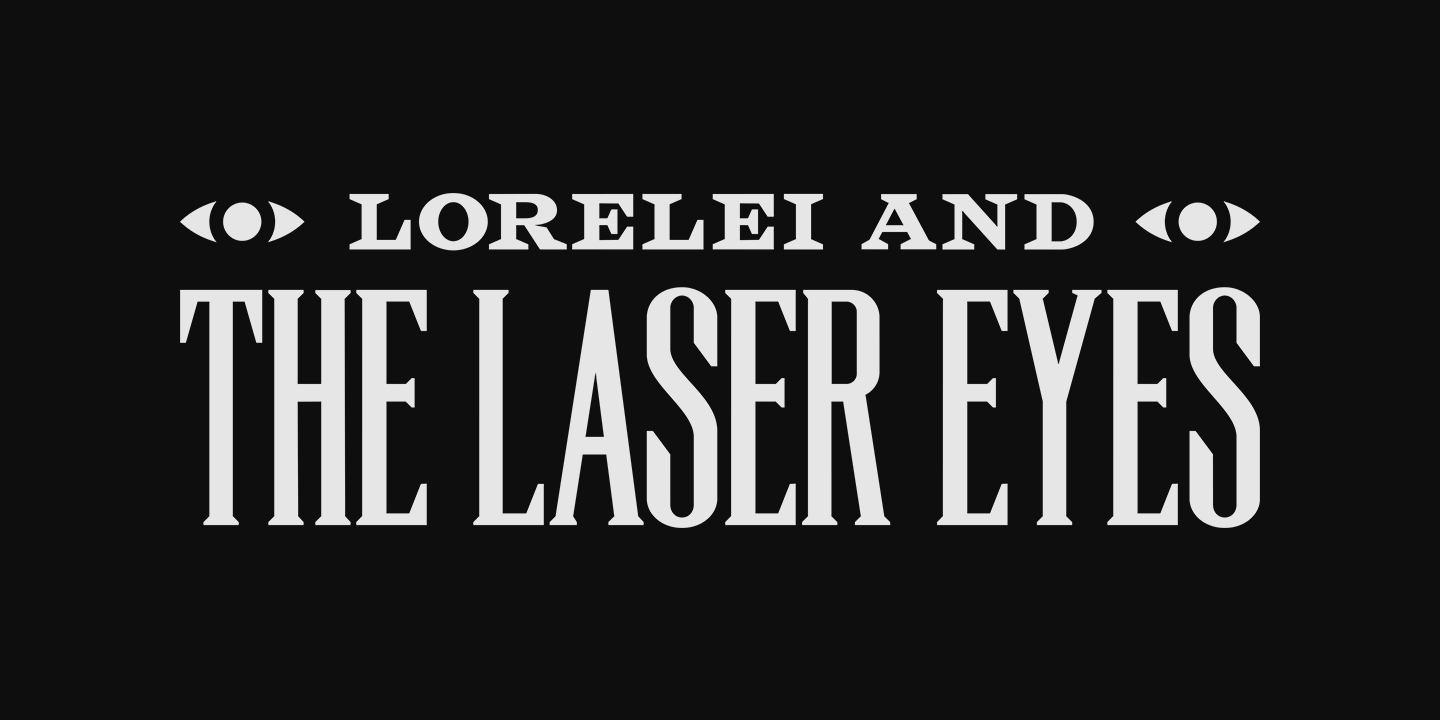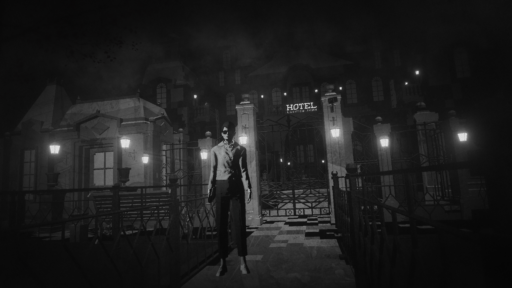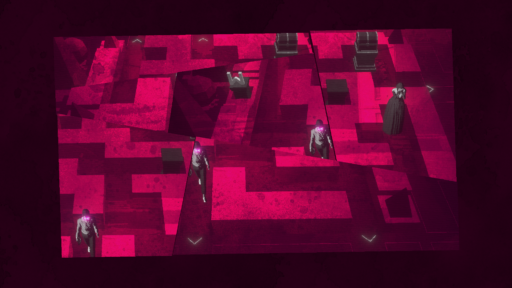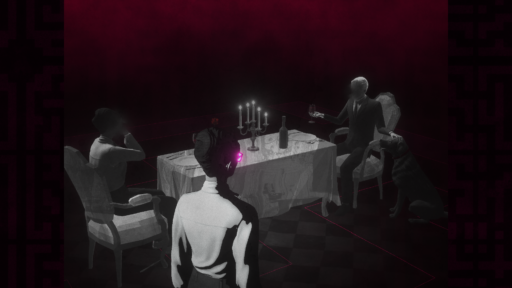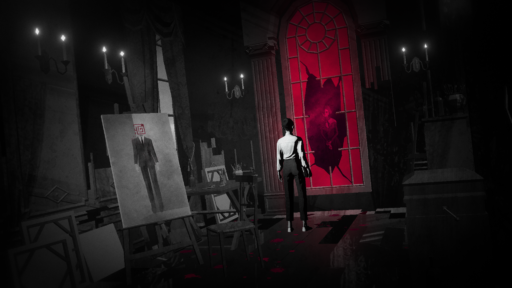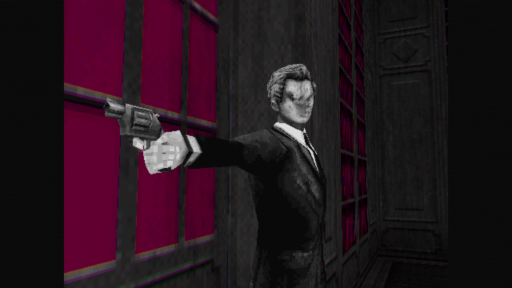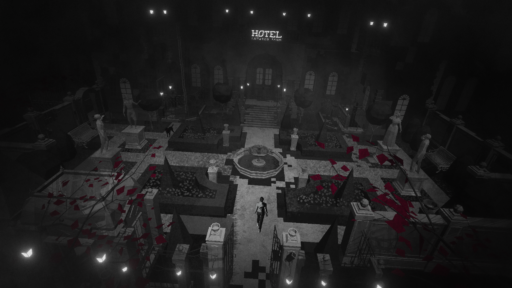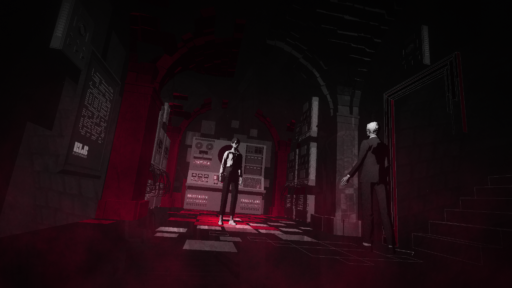
Lorelei and the Laser Eyes

Title:
Lorelei and the Laser Eyes

Genre:
Puzzle Mystery

First released:
May 16, 2024
A woman, summoned by an eccentric man to participate in a project in an old hotel somewhere in central Europe, becomes embroiled in a game of illusions, increasingly dangerous and surreal.
Now you are invited to fall into the same rabbit hole, in a non-linear mystery with an immense amount of handcrafted puzzles, constantly presenting you with new riddles to solve, each leading you closer to deciphering the enigma of Lorelei and the Laser Eyes.

Gameplay & Development
After finishing a big project, it’s easy to feel paralyzed. ”What now?” we asked ourselves after Sayonara Wild Hearts.
Simon had struggled with colors during Sayonara Wild Hearts, and so one of the first things we decided was that the next game should be black and white, and should have a slower tempo, be more contemplative, and perhaps be puzzle based. In a document where we had gathered ideas for fictive band names for our last game, Daniel had written “Lorelei and the Laser Humans”. Something struck a chord, but it didn’t exactly roll off the tongue. “Lorelei and the Laser… Eyes”. It was easy to imagine. At the time, Simon had started replaying the first Resident Evil

Once again, we called upon Carl Karjalainen to help us model, rig and animate a character. We started developing a small prototype, in which the only inputs were the right and the left shoulder buttons. One cycled selections, and the other modified the selected objects. A woman, wearing sunglasses, mysteriously levitating in minimalistic 3D-environments, with black and white projected photos over them. You’d solve image based puzzles, which would create images that you’d travel into. It had an interesting atmosphere, but we weren’t completely sold on the gameplay.
What followed were years of developing what were more or less almost complete games, some more action filled than others, but almost all based on interesting ideas about 3D space, and 3D cameras being incorporated into the gameplay. To be honest, we would like to keep these ideas close to our chest, as we think they are still interesting enough to develop into their own stand-alone things. But, somewhere along the way here, a story, and a second character came along. The man, accompanying the woman. Each represented light and dark, right and left. This was incorporated into gameplay, through different ways, always relating to the idea of playing with how you would actually view the game. As these characters and the story evolved, we felt that the game needed to become less mechanical and innovation-driven, and instead focus on more conceptual story ideas. At the time, Simon was reading a lot of Paul Auster
The game became more about ethereal concepts, while the gameplay became more classic, taking influences from traditional escape room puzzles and adventure games. Still, we had a lot of systems from our years of molding the game. We had developed a lot of different systems related to cameras (including systems for rendering several cameras at once), systems for allowing text based commands, systems for layouting text based documents, most important of all, a system which allowed us to change a lot of rendering parameters on the fly. All of these different systems could interplay and interact with each other in interesting ways. Lorelei and the Laser Eyes had become a very iterative toy box, in which it was easy to add and remove parts, and make new and interesting gameplay moments by combining the systems in different ways. It allowed us to make a game in which programmers could be relatively hands-off in the creation of gameplay, and puzzles.
Ideas about each player having their own experience with the game started forming, so we decided that its progression should be open-ended and that puzzles should have random elements, and be scrambled for every playthrough. We liked the idea that even if a player would use a guide to solve a puzzle, they would still need to understand the idea behind the puzzle to solve it, instead of just resorting to input a predetermined answer. Structurally, the game was inspired by Metroid

Ultimately, Lorelei and the Laser Eyes became a collage of styles, ideas, and disparate inspirations. Like wandering in memories.
Lorelei and the Laser Eyes was initially released on Nintendo Switch and Steam/PC May 16th 2024. The game launched on PlayStation 5 and PlayStation 4 December 3rd 2024. The PlayStation versions use controller audio and rumble/haptics when interacting with padlocks and other devices, to simulate that you are holding objects in your hands. It also uses the lightbar to simulate the sunglasses of the main character turning red.
To promote the game we designed and produced a custom notebook.

Images
From the very start, Lorelei and the Laser Eyes was planned to be black and white, with one contrasting ”laser” inspired, pinkish or red hue. Even though the game changed a lot during its development, a lot of the base elements remained the same throughout the project: toon shaded characters, low poly geometry with black and white photos projected on it, and wireframe style lines.
The intention was never to make the game look beautiful, but rather have it look like a collage of impressions, to give the feeling that you were wandering around in a broken computer world, full of memories. At first, we had hoped to license the black and white phototextures from various other works, such as L’Année dernière à Marienbad and the pre-rendered backgrounds from the Resident Evil remake, but it proved to be too complicated, and we ended up taking photos ourselves. We traveled to Kronovalls Slott

Sometimes, you are able to play other games within the game, and the art style changes to reflect this. There are times when the game shifts to look like a 1-bit adventure game or a PlayStation 1-style survival horror game. At other times, the player will read excerpts of books and other documents, and we spent a lot of time and effort on the font and document rendering.
Like she had done for Sayonara Wild Hearts, Åsa Wallander created all of the 2D art for the game, including promotion materials and logotypes.

Videos
Lorelei and the Laser Eyes was first revealed with a trailer in Nintendo Direct in 2022. The game changed a lot since then, and a lot of the gameplay found in that trailer has changed visually, and some elements have been completely revamped or removed.
The next time we showed the game in video form, was in Annapurna Interactive’s annual showcase. This time, we wanted to create a video that didn’t directly show any gameplay, but rather focused on the mystery and vibe of the game, with one long camera pan created in-game, with our cutscene editor. Christopher Sabat directed and produced the narration by Sean Henigan, and Emil Bengtsson helped us with the live action footage. We think this is one of the best trailers we have created.
The game was once again featured in Nintendo’s Indie World


May 23 2024 we released “Through The Laser Eyes”, a 9-minute video by Emil Bengtsson, in which the team contemplated and reflected on the project and the final product.

Music & Audio
Music always plays a big part in our games. Because of Lorelei and the Laser Eyes’ open structure, we didn’t quite know how we would incorporate music. We quickly realised that having traditional music constantly playing in the big manor would be distracting when solving puzzles, and so we came up with the idea of adding physical record players throughout the house, which would also help players navigate. When the records are off, it might seem like the game is almost quiet, but there are almost always “subtracks” playing. These are very ambient versions of each song, which are always perfectly matched to the songs playing on the phonographs. We didn’t want these to sound like actual music, but rather as if the house itself had a constant ghastly draft, that would always be in tune with the music.
We wanted the music in Lorelei and the Laser Eyes to be a little more complex and contemplative than Sayonara Wild Hearts. On the first playlist created, we had songs such as Life Round Here by James Blake


The direction started to shift from pop music, it was decided early on that piano should have a central role and we often referenced Debussy

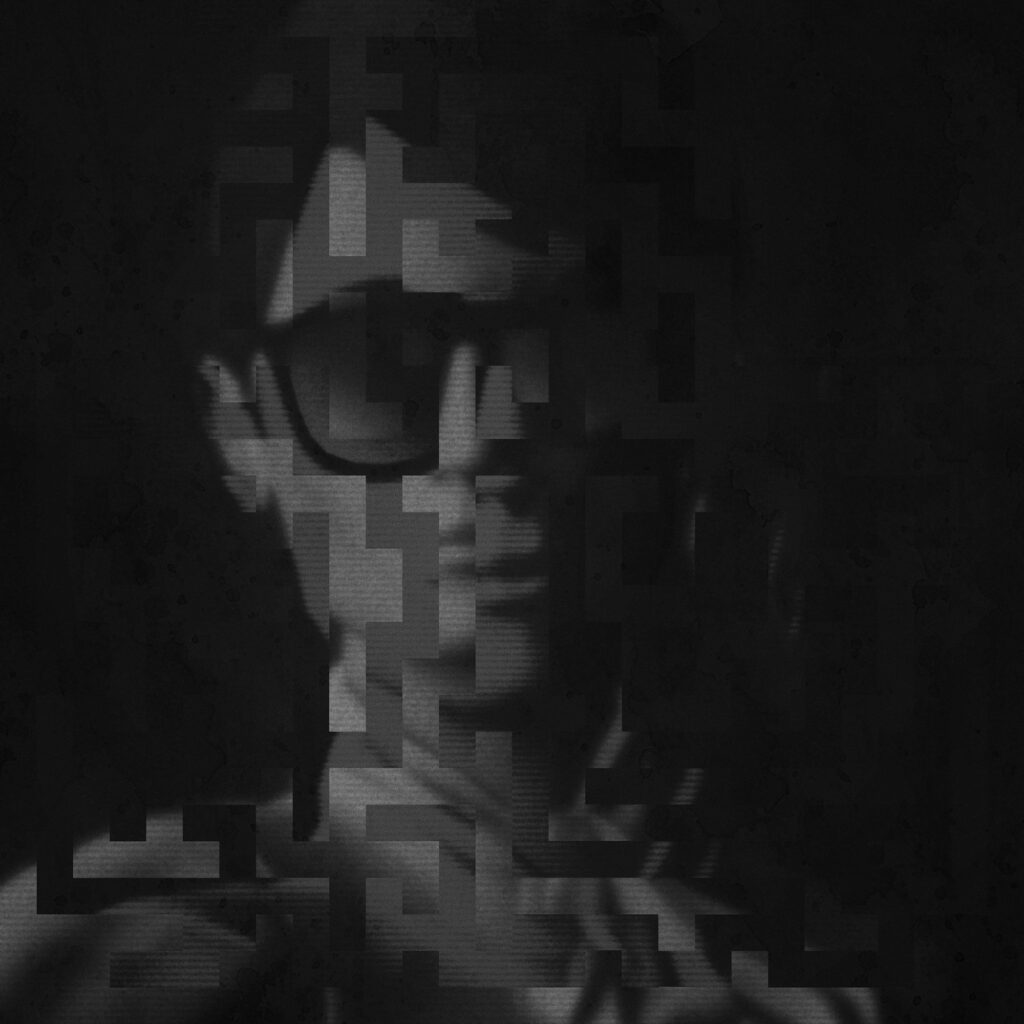
The soundtrack to Lorelei and the Laser Eyes by Daniel Olsén, Linnea Olsson and Jonathan Eng is available on Spotify

Game Credits
Art, sound, music & design direction, Level art & design, Story, Project management
Simon Flesser
Technical direction, Programming, Project management
Magnus “Gordon” Gardebäck
Programming
Magnus Jensen
Animation, Character and environment modelling, Tech art
Carl Karjalainen
2D art, Logo design, Project management
Åsa Wallander
Music, Sound design, Additional design & art
Daniel Olsén
Music, Vocals
Linnea Olsson
Music
Jonathan Eng
Story
Jonas Tarestad
Additional programming
Martin Rolén
Photographs taken on location at
Kronovalls Slott
Palladium Malmö
Made with the support of
Annapurna Interactive
Quality Assurance
HUWIZ QA/UX
Translation
EDS Wordland Ltd
Kakehashi Games
BADA GAMES
Keywords Studios

Reviews, Awards & Press
Reviews
Metacritic
Opencritic
The Guardian
Digital Trends
Press Start
Inverse
Hardcore Gamer
Checkpoint Gaming
But Why Tho?
The Gamer
Screen Rant
Game Rant
GamesRadar+
DualShockers
GGRecon
Well Played
Digital Chumps
Destructoid
GameSpot
TouchArcade
Game Informer
IGN
Thinky Games
Paste
The A.V Club
The Verge
Polygon
Kotaku
Room Escape Artist
EDGE 9/10
Awards
Most Innovative at the DIGY awards (Winner)
Game of the Year at Thinky Awards 2024 (Winner)
Best Presentation at Thinky Awards 2024 (Winner)
Chiclana & Friends ChiriGOTY Award (Winner)
Best Game Design at The Nordic Game Awards (Winner)
Best Aha Moment at Thinky Awards 2024 (Nominated)
Best Independent games at The Game Awards 2024 (Nominated)
Best Storytelling at Golden Joystick Awards (Nominated)
Best Indie Game at Golden Joystick Awards (Nominated)
Game of the Year at The EDGE Awards (3rd place)
Outstanding Achievement in Game Direction at the D.I.C.E. Awards (Finalist)
Best Design at Game Developers Choice Awards (Nominated)
Innovation Award at Game Developers Choice Awards (Honorable Mention)
Best Audio at Game Developers Choice Awards (Honorable Mention)
Best Game or Interactive Work at The Hugo Awards (Finalist)
Press
Game Informer’s (Belated) Top 10 Games Of 2024 Awards
Digital Trends – The 10 best video games of 2024
Checkpoint Gaming’s Game of the Year 2024
IGN – The Best Nintendo Game of 2024
Mashable – The 10 best video games you may have missed in 2024
GamesRadar+ – The 25 best games of 2024
Eurogamer – The 50 best games of 2024, ranked
GameSpot – The Best Games Of 2024
Bloody Disgusting’s 10 Best Horror Video Games of 2024
A.V. Club – The best games of 2024
Ars Technica’s top 20 video games of 2024
Polygon – The 50 best video games of 2024
Paste – The 40 Best Games of 2024
Vulture – The Best Video Games of 2024
NPR – The best games of 2024, picked by NPR’s staff
GQ – The Best Video Games of 2024
Nintendolife – The Influences & Craft Behind Lorelei And The Laser Eyes
The New York Times – A Puzzle Game With Roots in Resnais and Resident Evil
Engadget – Lorelei and the Laser Eyes preview: This may be my GOTY
Digital Trends – Lorelei and the Laser Eyes could be one of 2024’s best and boldest games
Press Start – Lorelei And The Laser Eyes Preview – You’re Going To Want To Write This Down
Venture Beat – Lorelei and the Laser Eyes preview: Overclock your thinking cap
The Indie Informer – Lorelei And The Laser Eyes Preview: May 16 Can’t Come Fast Enough
Digital Chumps – Lorelei and the Laser Eyes Preview
TouchArcade – Simogo 2024 Interview
Polygon – Lorelei and the Laser Eyes has a tampon because people carry tampons
TheGamer – Trust Me, Lorelei And The Laser Eyes Is A Party Game
Polygon – How Animal Well and Lorelei and the Laser Eyes fostered puzzle-solving communities

Age Ratings


ESRB content descriptors:
Mild Violence
Blood
Language
Alcohol Reference

